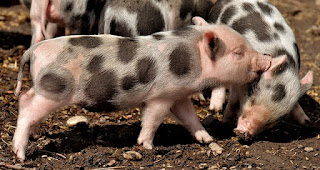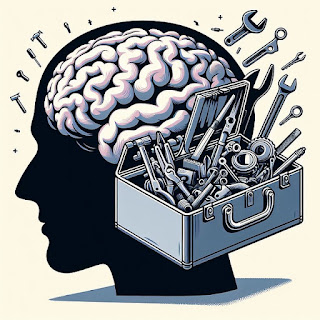The takeaway? While this is a great new tool to potentially help identify unknown people in a photo (or perhaps confirm your suspicions), it should be used with caution. Ideally, you'll be searching for people who you already have a photo of in your tree, where you'll be able to do your own comparison to see if you think the AI is correct. As with anything AI, it's best to double check everything. This is a big step in a new direction, but it's not a magic bullet.
Honoring those memorialized in family trees everywhere...and the ones yet to be discovered. Sharing inspiration, information & opinions for the journey finding family.
17 May 2024
Testing Ancestry's Photo Facial Recognition
14 May 2024
30 Free Genealogy Glossaries, Dictionaries and Abbreviation Resources
 |
| Image created using DALL-E and ChatGPT |
When you encounter these new and unfamiliar genealogical terms, where do you turn? Google is certainly usually my first step...but it doesn't always answer all my questions. In fact, sometimes I have more questions after a Google search than I had before! So for me, it's important to have a handy list of additional resources I can turn to.
Below are some sites where you can find great genealogical dictionaries, glossaries, information on abbreviations and much, much more! I've included Cyndi's List since there are even more references to be found there.
- Ancestry's Glossary of DNA Terms
- Ancestry’s Glossary of Genealogical Terms
- Berks County Genealogical Society - Helpful Tips Genealogy Terms
- Cyndi's List Genealogy Dictionaries & Glossaries
- Family History Daily 300 Historical Abbreviations Explained
- FamilySearch Research Wiki - A Glossary of Genealogical Terms
- FamilySearch Research Wiki: Genealogical Terms
- FamiyTreeDNA Glossary Terms
- Family Tree Magazine Genealogy Terms Glossary
- Family Tree Magazine Ultimate List of DNA and Genetic Genealogy Terms (+ Free Download)
- Genealogy in Time First Name Abbreviations
- Genealogy in Time Genealogy Word Dictionary
- Genealogy in Time Latin Dictionary
- Genealogy.com Genealogy Glossary
- Genealogy Quest Glossary of Terms
- Genealogy Trails – Genealogy Terms Encountered While Family Researching
- Gramps Project Genealogy Glossary
- International Society of Genetic Genealogy Wiki Genetics Glossary
- MyHeritage Genealogy Glossary: Common Genealogy Terms Explained
- MyHeritage Genealogy Glossary: Common DNA Terms Explained
- MyHeritage Guide to abbreviations and key genealogy terms
- National Cemetery Administration Headstone and Marker Inscriptions
- PBS History Detectives Genealogy Glossary
- Root To Branches Genealogy Terms Explained
- Roots Dictionary of Genealogy & Archaic Terms
- RootsWeb Genealogy Abbreviations
- RootsWeb Genealogy Terms
- The DNA Geek – A Genetic Genealogy Glossary
- Thomber.net Glossary of Old Medical Terms
- Treemily Comprehensive Glossary of Genealogical Terms
12 May 2024
5 Star Posts Week of 05/05/2024 - 05/11/2024
10 Company Blogs You Shouldn’t Miss by Bob Taylor on The Family History Guide Blog
What is the Furthest Anyone Has Traced Their Ancestry? by Mercedes Brons on Who Are You Made Of?
Who Do You Believe:? The Accuracy of Inherited Genealogy by James Tanner on Genealogy's Star
National Archives and Ancestry team up to digitize millions of records by Michael E. Ruaneon The Washington Post
Preserving the Story of America: Ancestry Announces Largest Archive Collaboration to Date with the National Archives and Records Administration by Ancestry (Ancestry Corporate press release)
Posts other Geneabloggers liked this week:
Best of the Genea-Blogs: Week of 5 to 11 May 2024 by Randy Seaver on Genea-Musings
Friday Family History Finds by Linda Stufflebean on Empty Branches on the Family Tree
This week’s crème de la crème — May 11, 2024 by Gail Dever on Genealogy à la carte
Image by Mohamed Hassan from Pixabay09 May 2024
This Little Piggy
I moved on to thinking about how they repaired and reused items. Where we often toss old broken items in the trash bin, for my ancestors, throwing away was a last resort when every bit of usefulness from every possible part had been gleaned. Clothes were mended and handed down, not donated or thrown away. When no longer wearable, they became the foundation for quilts. Many, like the one I remember from my childhood and still have, are treasured heirlooms. Bits of the past, squares and triangles stitched together, a lasting memory of the garments they came from. They found multiple uses for everyday items. Today, we're wide eyed when we find "101 uses for" [whatever the item may be]. In some cases, a single alternate use for a item today is a big win right? Back then, they probably knew tens if not hundreds of multiple uses by heart, because it was their way of life.
Today, we love to find recipes to feed our families for far less than we could have imagined and we're thrilled with the savings. Back then, they made everything they could from whatever they had. When my dad was a teenager, he got up every morning and jogged his trap line before dawn. Most of the meat the family ate came from whatever he caught (rabbit, squirrel, possum and even groundhog). A depression recipe I once stumbled on was Water Pie, and while I've not actually made it (yet), it's a reminder of the ingenuity of those who came before, finding a way to make something out of almost nothing. (I have an affinity for depression era recipes. I love collecting them. Simple meals are often the best in my mind.)
And then...my mind took a sharp turn...a trajectory to nursery rhymes. I was thinking about the "this little piggy". I know, it's totally random isn't it?! Now who doesn't know this rhyme?
This little piggy went to market
This little piggy stayed home
This little piggy had roast beef
This little piggy had none
This little piggy went ...
Wee, wee, wee, all the way home!
We've probably all heard it at some point, and those of us with children have probably passed it along to them as babies. According to mudcat.org, the opening line goes back as far as 1728, with abundant iterations to follow. The well known version seems to stem from about 1760. Apparently, varying versions of the rhyme can cause dissent amongst spouses. I found a thread where one woman wanted others to settle a disagreement between her and her spouse over the "proper" way to say the rhyme. Why was I even thinking about this?...
Because it isn't the way I was taught this rhyme. Oh no! My little piggies appear to have made an appearance in written history about 1890. I know the rhyme like this:
This little piggy went to market
This little piggy stayed home
This little piggy had bread and butter
This little piggy had none
And this little piggy went ...
Wee, wee, wee, all the way home!
When my male offspring was a wee, I taught him the way I was taught. But my ex-husband always said roast beef. At some point, my son innocently asked why my piggies didn't eat roast beef? So I told him the truth - "they were depression era piggies". I'm sure he had absolutely no clue...but it likely sounded important, and it seemed to quell his curiosity. My version eventually won out in our home.
The differences in the way of thinking and living, then and now, were swirling around in my head. I don't know if my ancestors felt like they were missing out, or if they were fairly content with their way of life. Some certainly seemed to have had it harder than others. But however they may have perceived their lives, I'm very thankful the frugal ways of the past were passed down through the generations to me. My ancestors passed on a fundamental foundation for living. In many areas of my life, frugality seems absolutely ingrained in my DNA.
I've enjoyed, and passed on, the love of apple, honey and maple syrup festivals (instead of going to amusement parks). I research purchases, find the best value for the money and then keep items for many years. A handmade gift or card is more valuable to me (in most cases) than a purchased item. One of my favorite books is The The Complete Tightwad Gazette: Promoting Thrift as a Viable Alternative Lifestyle by Amy Dacyczyn. (Not an affiliate link! You can likely find a copy at your local library, but sadly it has never been released on Kindle or as a eBook). I've read it cover to cover more times than I can count. I buy items on clearance. I stockpile consumables when on sale. I still struggle to throw away small amounts of leftovers (vs putting them in tiny Tupperware to save as a snack.) I still amass more mundane items than I need, because they might be useful one day. And my little piggies still have bread and butter.
Image by Alexa from Pixabay07 May 2024
Finding Resources in Unexpected Places
I don't know about you, but I can get in a rut. I check the various big genealogy sites (sometimes endlessly) hoping a new record will appear for an elusive ancestor. Sometimes I stumble across something new, but sometimes I need a fresh approach. So I'll trek over to some of the smaller genealogy sites, hoping for a breakthrough in smaller databases. And every once in awhile, I'm reminded to try a site where genealogy isn't the staple. You never know what you might find buried in a list of seeming unrelated links.
The Journalist's Toolbox is one of these non-genealogy sites. First, let me point out it appears there hasn't been a lot of really recent updating on the site. I can find pages last updated early 2023, but I also find some dead links. The easiest way to navigate is to search for something specific, or browse all topics. Many of the genealogy-ish links are to sites you'll probably find elsewhere (like the National Archives) or you're already familiar with (like the link to Ellis Island records), but there could be something hiding in there you might find useful. Below are some of the potentially useful links for genealogists:
AI for Journalists
Biography Sites
Copyright issues
FOIA and Finding Data
History
Miscellaneous Tools
Public Records
Reference Books
Search Tools
Translation Tools
By no means is this a site where you're going to find link lists dedicated to genealogy. It's simply an "off the beaten path" site with some limited potential. For content creators, there are also links to digital tools, social media tools, writing tools and various productivity tools. So if you're into sharing your genealogy journey, you may very well find some additional items of use on this site.
Image by Peter Middleton from Pixabay05 May 2024
5 Star Posts Week of 04/28/2024-05/04/2024
Ten Family History Bloggers You Should Know by Bob Taylor on The Family History Guide
2 Free Websites Compare Photos to See Who's Who by DiAnn Iamarino Ohama on Fortify Your Family Tree
DNA Painter: May Tech Moment by Linda Stufflebean on Empty Branches on the Family Tree
Beware of These “Red Flags” in Online Family Trees by Rachel Christian on FamilyTree
Transcribing Document Images with ChatGPT and Claude by Nicole Elder Dyer on Family Locket
AI’s Trust Problem by Bhaskar Chakravorti on Harvard Business Review
Posts other Geneabloggers liked this week:Best of the Genea-Blogs: Week of 28 April to 4 May 2024 by Randy Seaver on Genea-Musings
Friday Family History Finds by Linda Stufflebean on Empty Branches on the Family Tree
This week’s crème de la crème — May 4, 2024 by Gail Dever on Genealogy à la carte
Image by Mohamed Hassan from Pixabay03 May 2024
Ancestry Hacks: Ancestry Hints by Specific Record Collection
One of the best "secret genealogy hacks" (ok, maybe not super secret) I've come across is Mining Ancestry.com Hints by Specific Record Collection - Updated by Randy Seaver on Genea-Musings. This tip has been around years, and it still works! It's a trick I use quite frequently. He outlines how to search a specific record collection on Ancestry.com to find the people in your tree who currently show hints available in the specified database. This is done by using your Ancestry member tree number (treenumb) and the database number (dbas) in a carefully crafted URL. I won't go in to the specifics. Randy does a brilliant job of explaining the steps and I encourage you to read his post. It's a very simple trick to use. I want to tell you some of the reasons why I like it searching this way.
Have you ever wished, for instance, you could find all the yearbook hints? Those are fairly quick and easy to attach. Working thru quite a few in a single sitting is liberating (though still requires diligence to be sure you have the right person). Or Social Security Claims and Applications? Often a way to verify the child for a set of parents, along with the birth date, birth location, death date, social security number - and for females, potential other husbands surnames (from the notes). With a confirmed Social Security Number it makes working with SSDI records a breeze (cause you can easily confirm the SSN matches) and you often get the added state where the number was issued (and when) as well as the last residence/benefit address. Social Security records are some of my favorite record sets to work with when I want to make a small dent in my ever growing list of hints! Or all the FindAGrave entries or draft cards or....ok, ok, you get the idea. You can search for any database you want, so long as you know the number.
Any record set can be extra useful when narrowed down. Are you working on a specific branch of your family and want to see all the census records for a specific year? Perhaps you want to see who lives near who...or who moved away since the last census. Once you've narrowed to the specific database of interest, you can further narrow your search by first name, last name, or most recent hints (just like you can from the main list of all hints). This is a great way to focus in on specific parts of the family within a given dataset. Even public records, with the numerous addresses, when narrowed down, can help you figure out if the various people are all falling into the right place (pun absolutely intended). This isn't a magic solution to find elusive hints. Everything this search returns is already shown somewhere in your "all hints" listing. It just makes it easier to find the hints by filtering out the noise and letting you focus on a specific database for a period of time.
Randy provides a really good list of various database numbers to start you off. As I work, when I encounter a new database I'm running across frequently, I'll add the database number to my running list so I can go back and use it whenever I want. This "trick" has been around since at least 2013, and with a few tweaks to the original method over the years, it still works extremely well. It's definitely something you want to have in your genealogy toolbox. If you've never tried searching using this particular method, give it a go and see how you like it. Personally, I'm as excited about it now as I was when I first discovered it. Connect with me on social media (or leave a comment) and let me know how it works for you.
Image by Arek Socha from Pixabay








